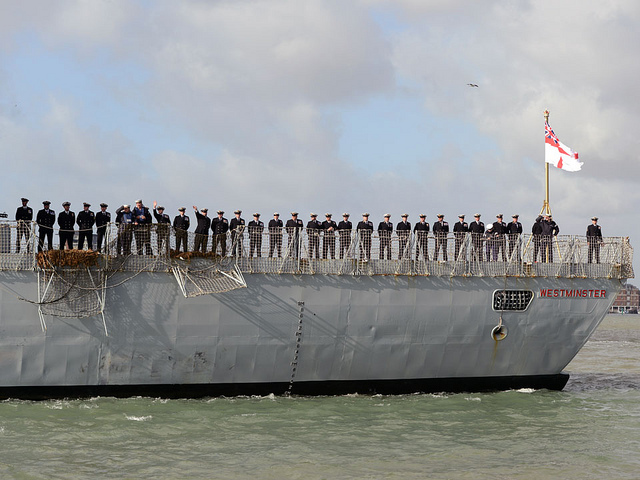
The British government is now fully committed to the Type 26 frigate. On 2 July, the Ministry of Defence announced that it had signed a contract for three hulls, probably the minimum it could get away with. The new frigate design has the designation ‘global combat ship’, which recognises that it’s intended to be capable of independent operations around the world, as well as forming part of a task group.
The design is theoretically specialised for anti-submarine warfare, but in practice will have general-purpose capabilities, including anti-surface and anti-air weapons. It won’t, however, manage the air defence of a task force, a job done in the Royal Navy by the Type 45 destroyer.
At just under 150 metres in length and well over 5,000 tonnes displacement, the Type 26 is not a small ship, but much of its size is to provide extended endurance and the capacity to carry additional personnel and equipment. It will have a flight deck capable of taking a Chinook and two hangars—one that can fit a Merlin helicopter and one intended for unmanned vehicles.
Given the trends in maritime warfare, it’s likely that the Type 26 will host ever more unmanned vehicles—air, surface and subsurface—as time goes on. The proliferation of unmanned vehicles and their need for host platforms is a key reason why the adage ‘steel is cheap and air is free’ applies to new surface combatants as never before. More and more, the capability of individual manned units will be determined by the types and numbers of unmanned systems that they can deploy.
There’s a certain amount of cynicism about this long-awaited announcement. Despite an ageing fleet, the motivation may have been not so much the preservation of the Royal Navy, but the fear of redundancies on the Clyde. A second element at play was recognition that the credibility of the Type 26 as a contender for our own Future Frigate project depended greatly on work being well underway in the UK before an Australian decision has to be made.
The whole class is meant to number eight units, but the Defence Ministry announcement reserved commitment to the final five units for the early 2020s. That confirms the budgetary problems that the British face, since it accepts the loss of substantial savings in the economies of scale possible with a single eight-ship buy as the price of not having to find the money until well into the future.
The other uncertainty is the follow-on Type 31 frigate design, supposedly a smaller and cheaper ship to make up the numbers that the RN so desperately needs. This was wished on the Navy as part of the last defence review by elements in the ministry that were more focused on providing a temporary solution to their budgetary problem than understanding the implications of such a mid-stream change of horses.
Whether Britain has the design capability to generate an additional surface combatant within a reasonable time is open to doubt, as is the ability to establish and run a second production line. What is not in doubt is that the Type 31 frigate’s start-up costs will exceed any possible savings made through restricting the Type 26 buy.
Time is running out. Even assuming a 35-year service life—which no British destroyer or frigate has ever achieved before (the Type 42 destroyer Liverpool was about the longest lived to date, achieving nearly 30 years between 1982 and 2012)—the British must replace 13 hulls between 2026 and 2035. Reducing the life of the Type 23 to a more sensible 30 years (still a decade more than the original design specifications) brings the timetable back to 2021–2030. The RN currently maintains 19 destroyers and frigates, although its personnel problems are such that it can’t fully man them. It’s a measure of how far British defence capability has been reduced that only 30 years ago the debate was about maintaining a force of 50 such ships. Unless priorities are reordered, that force will drop to 14 by 2030.
Yet the truth is that the RN’s greatest problem is manpower. The strength of the ‘naval service’ is usually given as 30,000, but that includes 7,000 Royal Marines. The latter are an extremely valuable and very efficient fighting force, but they can’t fill the technical billets needed to keep ships running.
At just over 23,000 RN officers and ratings, the service is too lean, and it is facing significant retention problems and shortages in key categories—exacerbated by such ‘leanness’. Two big carriers are being introduced into service, and the RN is expected to operate those along with four dual-crewed ballistic missile submarines, seven nuclear-powered attack submarines, 19 surface combatants, 15 mine countermeasure vessels, an amphibious group and a variety of survey ships and patrol vessels.
As is becoming clear, it can’t be done. The minimal increase in personnel authorised by the last defence review was merely a band-aid. Either Britain finds more resources for the RN (and its defence effort as a whole) or even greater force structure cuts will have to be made.

